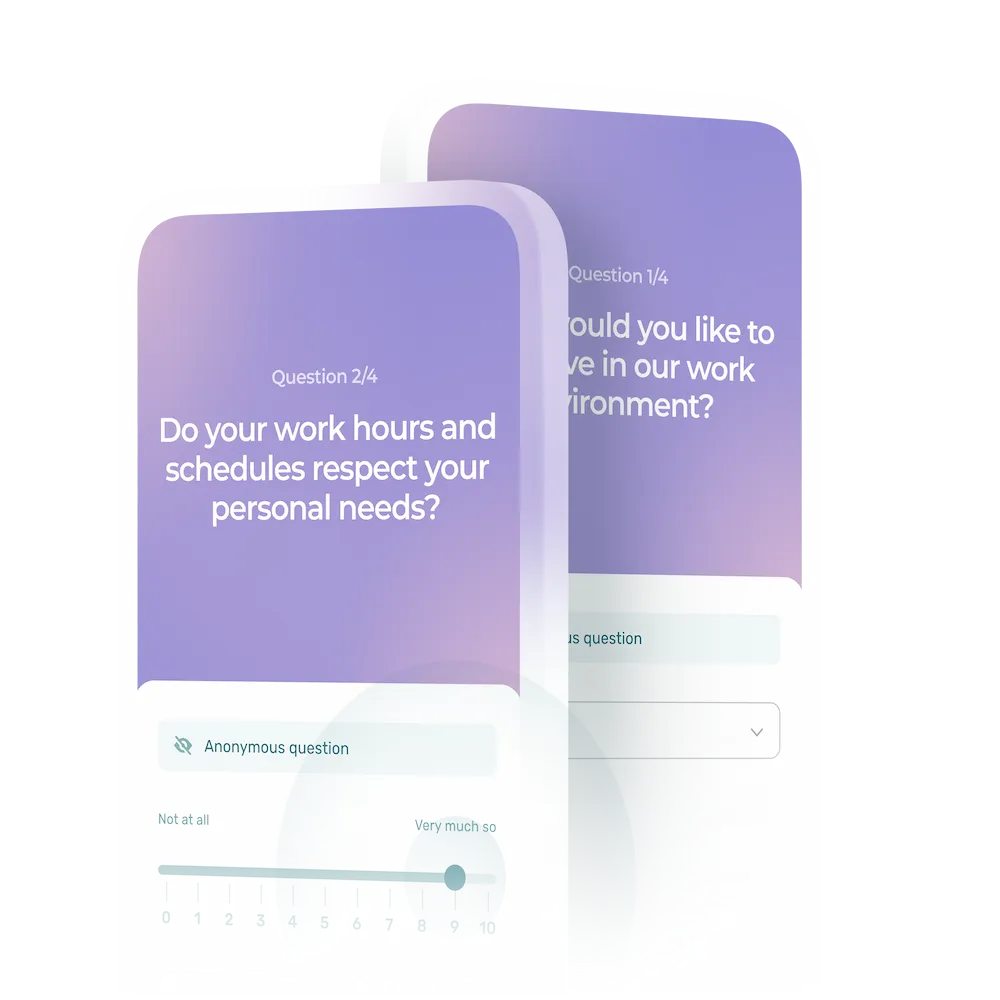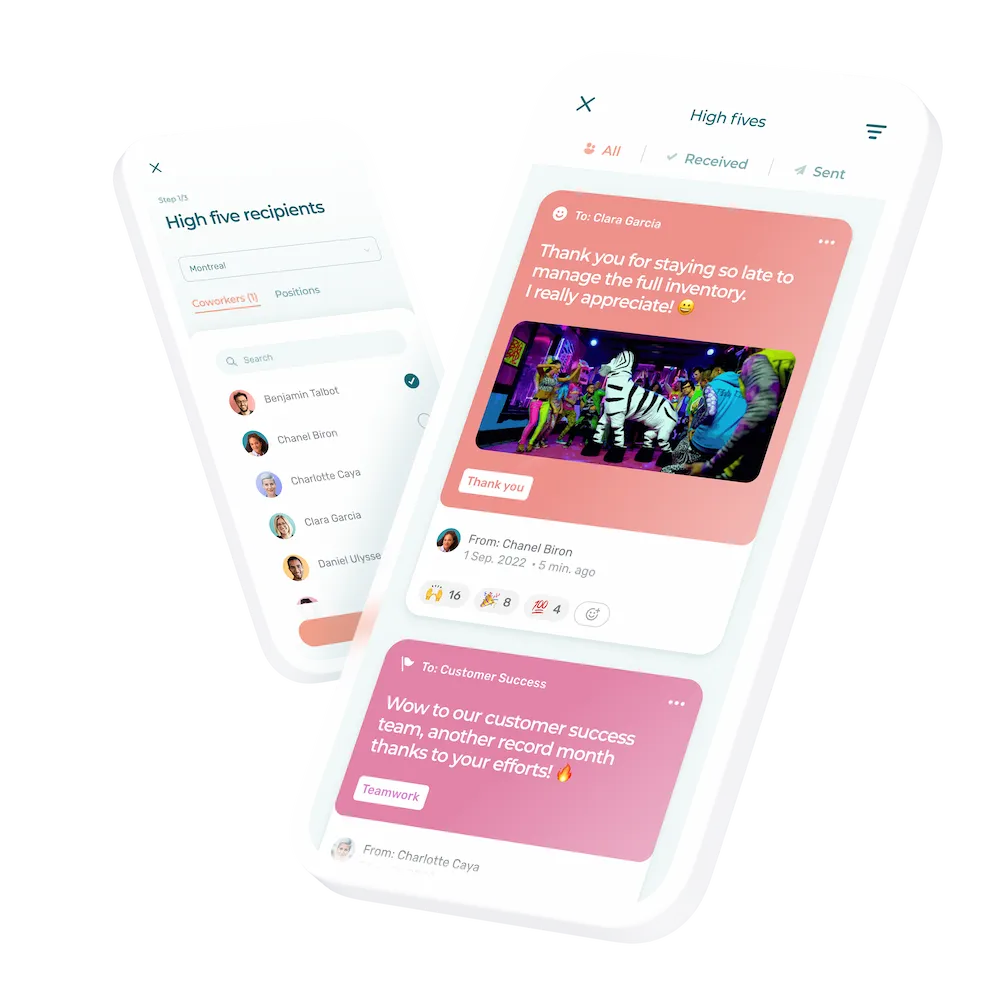Much is often said about well-being at work, the employee experience and company culture. But have you heard about quality of work life?
The concept of quality of work life (QWL) was born in the 1970s and gained traction in the 1980s. At that time, the emergence of new technologies, globalization and automation were raising concerns about working conditions and employees’ well-being.
Today, QWL remains a major issue for many organizations and a core component of human resources management and corporate social responsibility.
This article:
- Suggests a definition of QWL
- Identifies the risks associated with poor quality of work life
- Gives examples of how to improve QWL at your company
What Is Quality of Work Life?
The goal of quality of work life is to measure and improve the employee experience in a given workplace. This goes far beyond performance reviews, productivity levels and employee efficiency. The focus here is on well-being!
QWL is about considering employee needs, aspirations and expectations in order to create a more people-centred working environment where everyone can flourish. All this may sound a bit abstract—so where are we headed with all this, you ask? 🥸
In concrete terms, QWL has 5 pillars:
Health and Safety at Work
Employers must provide safe and healthy working conditions in order to safeguard the physical AND mental health of their employees.
💆♀️ Even if an employee has good sleep hygiene, eats well and exercises, if they experience anxiety that causes them problems at work, they won’t be able to fully thrive.
Work-Life Balance
The job must enable employees to reconcile their work with their personal lives and family responsibilities.
🤸♀️ After all, we work to live—not the other way around!
Autonomy and Empowerment
Managers need to offer employees some level of freedom and involve them in decision-making.
🏄♂️ Giving your employees autonomy empowers them to take on greater responsibility.
🎯 You’ll reach your targets more easily when you involve your staff in key company decisions.
Professional Development
The company must offer opportunities for skill development and ongoing training so that employees can advance in their careers.
🌱 Today’s employees may become tomorrow’s managers, so investing and believing in them is sure to benefit you.
A Positive Work Environment
Managers need to build a positive and authentic company culture rooted in values that are embodied on a daily basis.
🫶 Trust, collaboration and appreciation are excellent foundations for creating a positive work environment.
7 Consequences of Poor QWL
Companies that don’t take quality of work life seriously suffer the consequences. Here are a few easy-to-observe examples:
1. Deterioration in Work Atmosphere
The first thing to suffer when QWL is neglected is the work atmosphere. Relationships between departments can become strained when conflicts become more and more frequent between employees.
2. Lower Productivity and Motivation at Work
If employees are dissatisfied and demotivated, chances are they’ll be less productive and won’t do their best work. In turn, this may affect the quality of your company’s customer service.
3. Plummeting Employee Satisfaction
Employee engagement and satisfaction are often the third casualty when quality of work life is ignored. After all, if employees’ needs aren’t being taken into account, it’s unsurprising that they’ll be unsatisfied.
4. More Employee Problems
Team health and safety are essential to the smooth running of any business. Yet when QWL is not made a priority, employees can experience stress, burnout and health problems. Not to mention absenteeism, which accounts for 6% of the payroll in Canadian companies.
5. Higher Employee Turnover
Unsurprisingly, unmotivated and disengaged employees frequently leave their jobs. Companies with high staff turnover will have to put large sums of money into recruiting and training new employees.
6. Negative Impact on Company Image
In terms of the company at large, poor QWL can tarnish the corporate image. Word of mouth spreads quickly, and current employees, potential candidates and customers alike can be put off by what they hear about an organization.
7. Difficulty Recruiting New Employees
Ultimately, companies that do not value quality of work life will struggle to attract and retain competent talent—who, predictably, will opt for employers that take their well-being to heart.
QWL and Your Company: Where to Begin?
Now that we’ve covered some of the risks facing companies that overlook quality of work life, let’s turn to some ideas to inspire you to incorporate QWL into your own management practices. 🚀
Focus On Flexible Working Arrangements
Telework and flexible working hours are outstanding yet low-cost ways to enhance quality of work life. They also support a healthy work-life balance for your employees.
Can’t offer telework at your company? Opt for other alternatives. See our 9 ways to offer flexibility at work when teleworking isn’t an option.
Offer Stress Management Solutions
Between demanding customer service, last-minute orders, heavy traffic and emergencies, work can be highly stressful for your team nowadays. So, implement solutions to help your employees manage stress at work.
Here are a few ideas (including one or two wackier ones!🤪) that have been applied by managers I know. No matter what, survey your employees before you try anything—they’ll be able to tell you what speaks to them!
- Wellness or mental health days: Everyone needs a break now and then. At Agendrix, we’re entitled to 5 wellness days per year. They can be taken at a moment’s notice, no questions asked. Is your child sick? Did your dog eat a light bulb? Did someone invite you to go sailing? Is a snowstorm looming and you just can’t say no to a pow day? That’s what these days off are for!
- Don’t let workplace conflicts fester: As soon as conflicts arise in your team, do what you can to resolve them. This can even mean swapping shifts if two employees are really not getting along.
- Subscription to a meditation app: If you run a call centre or work in healthcare or the events industry, chances are your team must cope with daily stress. Why not offer your team a subscription to a meditation app such as Headspace?
- A punching bag in the break room: Does your team run on adrenaline or go through periods of intense stress? An outlet will no doubt be welcome. 🥊
- Be there for your employees: When you see that someone needs help, go and lend a hand. If someone doesn’t seem to be feeling well, take the time to talk to them, and above all, listen actively.
Being present as a manager is probably the least expensive option that will have the greatest impact on your team’s morale.
Become a Leader in Diversity and Inclusion
Creating an equitable, non-discriminatory working environment where everyone is valued is not only a great step to promoting QWL. It is your duty as an employer under the law. So why not become a leader in diversity and inclusion?
Diversity encompasses all characteristics of your staff, such as their age, religion, ethnic origin, marital status, sexual orientation, disability, etc. Inclusion, for its part, is about valuing and accepting each individual at a company, regardless of their background, history, etc.
Among other things, you can use inclusive language in your communications, celebrate the holidays of your team’s various cultures, put in place training to raise employee awareness, and implement a zero-tolerance policy toward any form of discrimination within your organization.
Stimulate Your Team With Continuous Learning
Professional development is one of the key pillars of quality of work life. Offer opportunities that will enable your employees to remain competitive in a fast-changing job market.
Offer advanced sommelier training for your waiters, sales training for your clerks, staff management courses for your rising stars, scholarships for your employees who wish to pursue higher education on a part-time basis, and so on. The only limits are your imagination and your budget!
I’d like to take this opportunity to share with you a quote that I like to remind managers of from time to time:
CFO asks CEO: What happens if we invest in developing our people and then they leave us?
CEO: What happens if we don’t, and they stay?
Build a Culture of Recognition
Although your salary and working conditions are a form of recognition for your employees, don’t stop there. Everyone likes to feel that their work is useful and appreciated.
Get into the habit of regularly thanking your employees, and encourage them to thank one another. Employees’ sense of belonging and team spirit at your organization will soar. And so will their productivity!
Lacking inspiration? Here are some ideas in the way of recognition messages for your team.
Simplify Certain Tasks With the Help of Technology and Automation
Some tasks can be mind-numbing and a waste of your team’s time. The same is true for you as a manager. So put technology to good use and free up time in your day to be available to your employees and customers.
- Adopt scheduling software
- Centralize your team’s communications somewhere other than Facebook Messenger
- Use a project management tool to avoid duplicate tasks
- Switch from manual punching to an online time punch tool connected to your payroll system
- And more!
Make Work Meaningful
What motivates you to get up in the morning, and what drives you at work? Share this vision with your team to help them identify with your values and your company mission. Embody your values in your everyday life! This will attract people with similar values.
QWL Is Everyone’s Responsibility!
Considering that we spend around a third of our lives at work—that’s right, one third, or the equivalent of 90,000 hours ⏳—we might as well offer a workplace where everyone can thrive, grow and develop. The beauty of QWL is that it’s always a work in progress and anyone can pitch in. And just because you try something out this month doesn’t mean you have to commit to it for the next 15 years.
Involve your employees: although your role as a manager gives you greater influence, employees are quite capable of sharing their ideas and helping you improve the quality of life at work.
I’ll leave you with a small challenge: why not give your team members QWL objectives for their next performance review?
What Is Quality of Work Life (QWL)?
Quality of work life (QWL) refers to the various strategies a company puts in place to create a healthy, fulfilling and productive work environment. QWL focuses on both individual and collective actions aiming to improve working conditions, employee well-being and company performance.
It has 5 main pillars:
- Health and safety
- Work-life balance
- Employee autonomy and empowerment
- Professional development
- A positive and inclusive work environment
Where Does the Concept of QWL Come From?
The concept of quality of work life emerged in the 1970s and gained momentum in the 1980s. This was a period when many concerns arose about working conditions and well-being, given the changes taking place in the world of work. Examples included globalization, new technologies and workplace automation.
How Do You Measure QWL at a Company?
QWL cannot be measured using a single indicator, but based on a multitude of data that provides an overview of the situation. Tracking and analyzing indicators helps identify areas for improvement, as well as concrete actions to implement.
Managers wishing to measure QWL at their organization can:
- Conduct regular employee surveys: this can include questions about work-life balance, job satisfaction, employee relations, peer recognition, etc.
- Track health and safety indicators: this helps pinpoint and correct shortcomings, especially in a context where workplace accidents have been on the rise.
- Conduct performance evaluations: these assessments are an opportunity to check on employees’ job satisfaction, tasks, colleagues and work environment.
- Calculate employee turnover: If turnover is high, this may indicate issues with employee well-being and job satisfaction.
- Observe absenteeism rates: This is a key indicator for assessing quality of work life, since it uncovers whether employees may be experiencing health or motivation problems.
- Ask customers for feedback: This helps validate the quality of customer service provided by employees. Satisfied staff will be more inclined to provide better customer service, whereas dissatisfied employees will tend to be more impatient.












